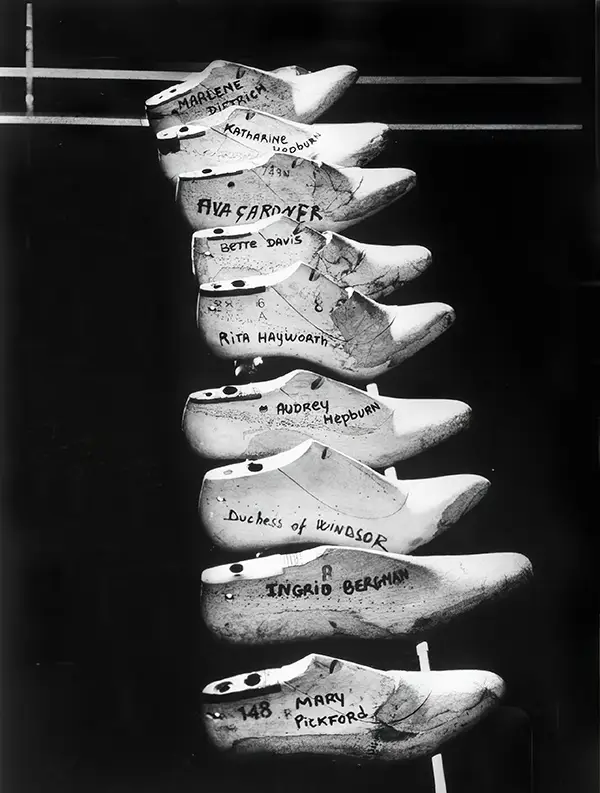Over a century ago, in the heart of bustling Hollywood Boulevard, a man with a dream and a passion for shoes opened a small shop. This man was Salvatore Ferragamo, and his journey in the world of footwear began in a modest storefront across from the iconic Egyptian Theater. His shop soon became a symbol of Hollywood glamour, earning him the prestigious title of the “shoemaker to the stars.”
Ferragamo’s shoes were more than just footwear; they were works of art. They adorned the feet of the silver screen’s finest, from Marilyn Monroe to Audrey Hepburn. His innovative designs and impeccable craftsmanship set him apart in the fashion world, making his name synonymous with luxury and sophistication. Photos from this time reveal the elegance and beauty of his creations, showcasing the unique styles that captivated Hollywood’s elite.
Salvatore Ferragamo was born in 1898 into a modest family in Bonito, Italy. He was the eleventh child among fourteen siblings of Antonio and Mariantonia Ferragamo. His early passion for shoemaking became clear when, at just nine years old, he crafted his first pair of shoes: a set of high heels for himself and matching pairs for his sisters to wear at their confirmation. This experience ignited a lifelong passion, leading him to realize that shoemaking was his true calling.
At the age of fourteen, Ferragamo opened a small store in his parents’ home after studying shoemaking in Naples for a year. In 1915, he immigrated to Boston, Massachusetts, where one of his brothers worked in a cowboy boot factory. Although his time at the factory was brief, it helped shape his understanding of footwear. Soon after, he persuaded his brothers to join him in California, first settling in Santa Barbara and later moving to Hollywood.
Read more
In Hollywood, Ferragamo found success by opening a shop specializing in shoe repair and made-to-measure footwear. He quickly gained a reputation for his skills and creativity. However, he was not willing to accept that shoes could be beautiful but uncomfortable to wear. To address this, he studied anatomy at the University of Southern California. This unique approach set him apart from other shoemakers and ensured that his designs were both stylish and functional.
After spending thirteen years in the United States, Ferragamo returned to Italy in 1927, choosing Florence as his new home. There, he began creating shoes for notable women, including the Maharani of Cooch Behar and Eva Perón. His work caught the eye of Hollywood stars, and he soon began designing footwear for icons like Marilyn Monroe. Ferragamo opened a workshop in the Via Mannelli, where he experimented with innovative designs and applied for patents for his groundbreaking creations.
Despite facing challenges, including bankruptcy in 1933 due to financial mismanagement and economic difficulties, Ferragamo managed to revive his business in the 1950s. By this time, he had expanded his operations to employ 700 artisans who meticulously crafted 350 pairs of shoes by hand each day. His commitment to quality and design remained unwavering, and his reputation continued to grow.
One of Ferragamo’s most iconic creations is “The Rainbow,” a platform sandal designed for the famous American singer and actress Judy Garland in 1938. This shoe marked the resurgence of the platform in the modern Western world. “The Rainbow” was a tribute to Garland’s signature song “Over the Rainbow” from the classic film *The Wizard of Oz* (1939). The sandal was crafted using shaped slabs of cork covered in suede, with gold kidskin straps. Ferragamo was inspired to experiment with new materials that were not rationed during World War II, showcasing his creativity and resilience.
Salvatore Ferragamo passed away in 1960 at the age of 62, but his legacy continued through his family and the brand he built. His wife, Wanda, assumed leadership of the company, later joined by their six children—Fiamma, Giovanna, Fulvia, Ferruccio, Massimo, and Leonardo. Together, they steered the company toward global success, expanding its offerings to include luxury shoes, bags, eyewear, silk accessories, watches, perfumes, and a ready-to-wear clothing line.
Throughout his career, Ferragamo invented many unique designs, but his most famous invention is arguably the “Cage heel.” This innovative design showcased his ability to blend art with function, and it quickly became a favorite among fashion enthusiasts. Fiamma, Salvatore’s eldest daughter, contributed to the family legacy by creating the “Vara pumps” in 1978, which remain popular to this day.





















